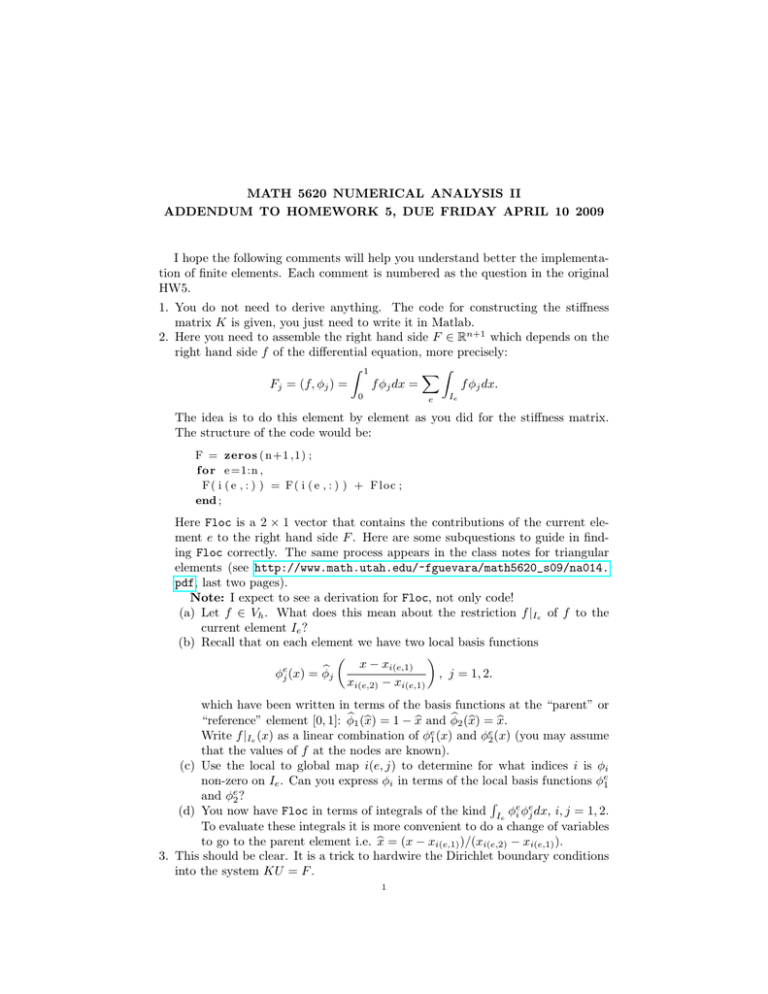MATH 5620 NUMERICAL ANALYSIS II
advertisement

MATH 5620 NUMERICAL ANALYSIS II ADDENDUM TO HOMEWORK 5, DUE FRIDAY APRIL 10 2009 I hope the following comments will help you understand better the implementation of finite elements. Each comment is numbered as the question in the original HW5. 1. You do not need to derive anything. The code for constructing the stiffness matrix K is given, you just need to write it in Matlab. 2. Here you need to assemble the right hand side F ∈ Rn+1 which depends on the right hand side f of the differential equation, more precisely: Z 1 XZ f φj dx. Fj = (f, φj ) = f φj dx = 0 e Ie The idea is to do this element by element as you did for the stiffness matrix. The structure of the code would be: F = zeros ( n +1 ,1) ; f o r e =1:n , F( i ( e , : ) ) = F( i ( e , : ) ) + F l o c ; end ; Here Floc is a 2 × 1 vector that contains the contributions of the current element e to the right hand side F . Here are some subquestions to guide in finding Floc correctly. The same process appears in the class notes for triangular elements (see http://www.math.utah.edu/~fguevara/math5620_s09/na014. pdf, last two pages). Note: I expect to see a derivation for Floc, not only code! (a) Let f ∈ Vh . What does this mean about the restriction f |Ie of f to the current element Ie ? (b) Recall that on each element we have two local basis functions x − xi(e,1) e b φj (x) = φj , j = 1, 2. xi(e,2) − xi(e,1) which have been written in terms of the basis functions at the “parent” or “reference” element [0, 1]: φb1 (b x) = 1 − x b and φb2 (b x) = x b. Write f |Ie (x) as a linear combination of φe1 (x) and φe2 (x) (you may assume that the values of f at the nodes are known). (c) Use the local to global map i(e, j) to determine for what indices i is φi non-zero on Ie . Can you express φi in terms of the local basis functions φe1 and φe2 ? R (d) You now have Floc in terms of integrals of the kind Ie φei φej dx, i, j = 1, 2. To evaluate these integrals it is more convenient to do a change of variables to go to the parent element i.e. x b = (x − xi(e,1) )/(xi(e,2) − xi(e,1) ). 3. This should be clear. It is a trick to hardwire the Dirichlet boundary conditions into the system KU = F . 1 2 MATH 5620 HOMEWORK 5 ADDENDUM 4. Here you do the actual calculations for f (x) = exp(x). Obviously f ∈ / Vh , however pretend f is piecewise linear to use the code to assemble the right hand side F above (i.e. you can evaluate f (x) at the nodes and run it through the code from previous question). Solve the system using Matlab’s backslash “\” (do help slash to see the syntax). For n = 10 you should get a maximum error of the order of 10−4 . If you don’t, there is something wrong with your right hand side. 5. The error should be O(h2 ), you have to convince me that the convergence rate in your log-log plot is consistent with this.











